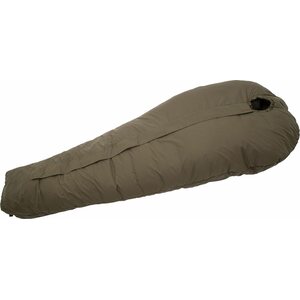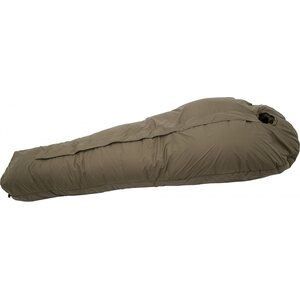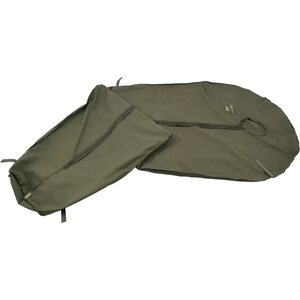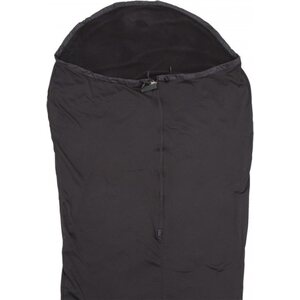(167,25 - 175,22 €, TVA 0)

Sleeping bag is, along with a proper sleeping pad, one of the most important factors in a successful trip. When you rest well at night, you will have energy for adventures on the next day. The factors which affect the choice of the sleeping bag are basically the use temperature, your size, and the thermal comfort features of the bag.
To make it easier to compare different sleeping bags, a sleeping bag temperature standard EN 13537 has been developed. With the help of this standard, it is easier compare sleeping bags of different manufacturers with each other. However, some of the manufacturers use ratings which differ from the EN 13537 standard, especially for the thickest winter sleeping bags, based on their own experiences.
For example, the marking “-2 ºC comf, -8 ºC lim, -27 ºC ext” on a sleeping bag can be explained as follows:
Comfort (2 ºC): At this temperature, an average woman sleeps through the night comfortably. Check this rating also if you are often cold or you do not have a lot experience of sleeping outside.
Limit (-8 ºC): At this temperature, an average man sleeps through the night without waking up because of the coldness. Check this rating if you already have experience of sleeping outside and can estimate your tolerance to the cold.
Extreme (-27 ºC): This rating does not mean that the sleeping bag is enough at the temperature in question. The temperature marking means that an average woman can make it at this temperature for six hours without a risk for death caused by hypothermia.
The ratings have been tested with dummies, an “average man” being 25 years old, 173 cm tall, and weighing 73 kg, and an “average woman” being 25 years old, 160 cm tall, and weighing 60 kg. The ratings are meant to be approximative, and they cannot be completely trusted without experience, since people sense cold and hot in different ways. The gender-based categorisation of sleeping bags is also connected to the generalised differences of temperature comfort limits between men and women. In general, the body composition of women is different and tolerates the cold in a different way than men on average. In addition, the insulation material in the so-called women’s sleeping bags is put in different places than the material in the so-called men’s / unisex bags.
It must be said that the women’s bags are not just for women, and vice versa. The gender-based classification is based on a generalisation, and there are naturally individual differences. So being, anyone can choose any kind of bag, if it matches their own comfort needs.
You also need to remember that you need a sufficient sleeping pad to insulate the coldness of the ground and in this way ensure that the ratings are realised.
Cum să alegi o saltea de camping
The most common filling materials used in sleeping bags are down and different synthetic fibres, and in some cases, the combination of these two.
The benefit of down as insulating material is its insulating capacity in relation to its weight. Down also packs in a smaller space than synthetic fibres, and this feature becomes more important in thicker bags. Earlier, the weakness of down was the weakening of its insulating capacity when the bag got wet, but nowadays many sleeping bag manufacturers treats the down in a way that it repels humidity considerably better than without the treatment.
The benefit of the synthetic filling is that it does not require any special treatments, but it stays airy even when wet without any treatments. Synthetic bags are also a cheaper option compared to the down bags.
There is variation in both filling categories.
There is down of different qualities, and it is measured with a special cuin or fillpower values. In general, you can say that when the value rises above 600, the filling is of very high quality. The higher the value, the better the insulating capacity of down in relation to its volume.
There are differences also in synthetic fibres, affecting the weight, the packability and the insulation capacity of the bag.








When you are choosing a sleeping bag, you need to take into consideration also other things besides the quality and the quantity of the filling.
There are sleeping bags of different sizes, and it is important not to choose too big or too small a sleeping bag.
If there is a lot of empty space everywhere in the sleeping bag, the body needs more energy to warm up the extra space, and the bag may feel cold even it was thick.
The problem with too narrow or short a sleeping bag is that your feet might flatten the filling, so there will not be enough insulation at this spot and the feet will be cold.
If you are used to sleep on your side, take this into consideration when you choose a sleeping bag. The most lightweight and narrow models are necessarily not suitable for you in this case. Some manufacturers also offer sleeping bags specifically designed for side sleepers.
To make sure that a sleeping bag is suitable, it is possible to try different models in our shop and find a perfect model for you.
In addition to the length, there are differences also in the shape of the bag and the hood, and there are also different shell fabrics. In the sleeping bags designed for cold weather, there is a draft collar that seals in heat so it cannot escape when you move around at night. You can find information on other product-specific features in the product description pages.
If you use an inner sheet in your sleeping bag, you do not have to wash the sleeping bag so often. Washing a sleeping bag is quite difficult, it wears out the bag, and a down bag is difficult to dry. You can use an inner sheet also as such in warm conditions or improve the thermal insulation of your sleeping bag. There are sheets of many different materials with different thermal values. Besides the thermal values, different material packs into different sized packages.
A tip! If you borrow or lend a sleeping bag, it is nicer to everyone that the borrower use his/her own sheet. It feels more hygienic when you don’t have to sleep in other people’s odours.







